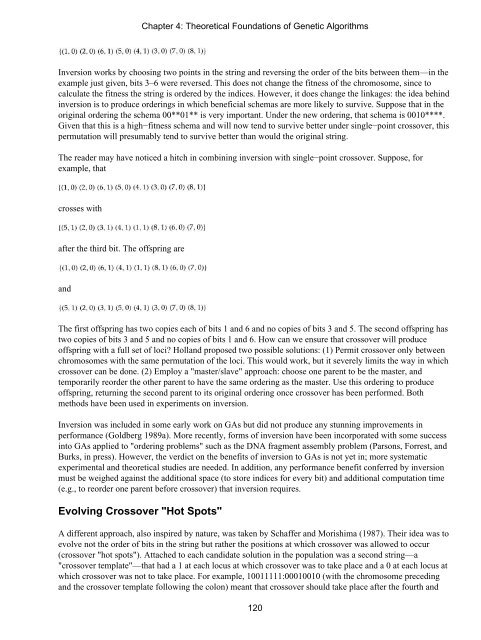An Introduction to Genetic Algorithms - Boente
An Introduction to Genetic Algorithms - Boente
An Introduction to Genetic Algorithms - Boente
You also want an ePaper? Increase the reach of your titles
YUMPU automatically turns print PDFs into web optimized ePapers that Google loves.
Inversion works by choosing two points in the string and reversing the order of the bits between them—in the<br />
example just given, bits 3–6 were reversed. This does not change the fitness of the chromosome, since <strong>to</strong><br />
calculate the fitness the string is ordered by the indices. However, it does change the linkages: the idea behind<br />
inversion is <strong>to</strong> produce orderings in which beneficial schemas are more likely <strong>to</strong> survive. Suppose that in the<br />
original ordering the schema 00**01** is very important. Under the new ordering, that schema is 0010****.<br />
Given that this is a high−fitness schema and will now tend <strong>to</strong> survive better under single−point crossover, this<br />
permutation will presumably tend <strong>to</strong> survive better than would the original string.<br />
The reader may have noticed a hitch in combining inversion with single−point crossover. Suppose, for<br />
example, that<br />
crosses with<br />
after the third bit. The offspring are<br />
and<br />
The first offspring has two copies each of bits 1 and 6 and no copies of bits 3 and 5. The second offspring has<br />
two copies of bits 3 and 5 and no copies of bits 1 and 6. How can we ensure that crossover will produce<br />
offspring with a full set of loci? Holland proposed two possible solutions: (1) Permit crossover only between<br />
chromosomes with the same permutation of the loci. This would work, but it severely limits the way in which<br />
crossover can be done. (2) Employ a "master/slave" approach: choose one parent <strong>to</strong> be the master, and<br />
temporarily reorder the other parent <strong>to</strong> have the same ordering as the master. Use this ordering <strong>to</strong> produce<br />
offspring, returning the second parent <strong>to</strong> its original ordering once crossover has been performed. Both<br />
methods have been used in experiments on inversion.<br />
Inversion was included in some early work on GAs but did not produce any stunning improvements in<br />
performance (Goldberg 1989a). More recently, forms of inversion have been incorporated with some success<br />
in<strong>to</strong> GAs applied <strong>to</strong> "ordering problems" such as the DNA fragment assembly problem (Parsons, Forrest, and<br />
Burks, in press). However, the verdict on the benefits of inversion <strong>to</strong> GAs is not yet in; more systematic<br />
experimental and theoretical studies are needed. In addition, any performance benefit conferred by inversion<br />
must be weighed against the additional space (<strong>to</strong> s<strong>to</strong>re indices for every bit) and additional computation time<br />
(e.g., <strong>to</strong> reorder one parent before crossover) that inversion requires.<br />
Evolving Crossover "Hot Spots"<br />
Chapter 4: Theoretical Foundations of <strong>Genetic</strong> <strong>Algorithms</strong><br />
A different approach, also inspired by nature, was taken by Schaffer and Morishima (1987). Their idea was <strong>to</strong><br />
evolve not the order of bits in the string but rather the positions at which crossover was allowed <strong>to</strong> occur<br />
(crossover "hot spots"). Attached <strong>to</strong> each candidate solution in the population was a second string—a<br />
"crossover template"—that had a 1 at each locus at which crossover was <strong>to</strong> take place and a 0 at each locus at<br />
which crossover was not <strong>to</strong> take place. For example, 10011111:00010010 (with the chromosome preceding<br />
and the crossover template following the colon) meant that crossover should take place after the fourth and<br />
120






